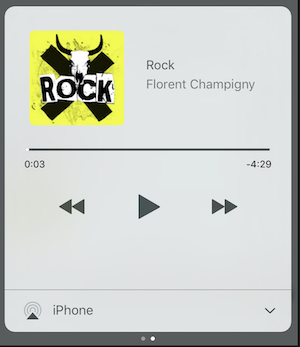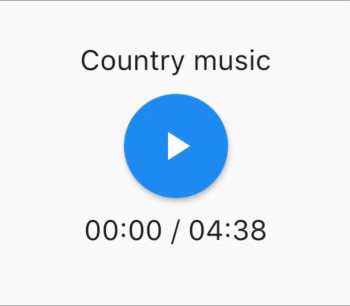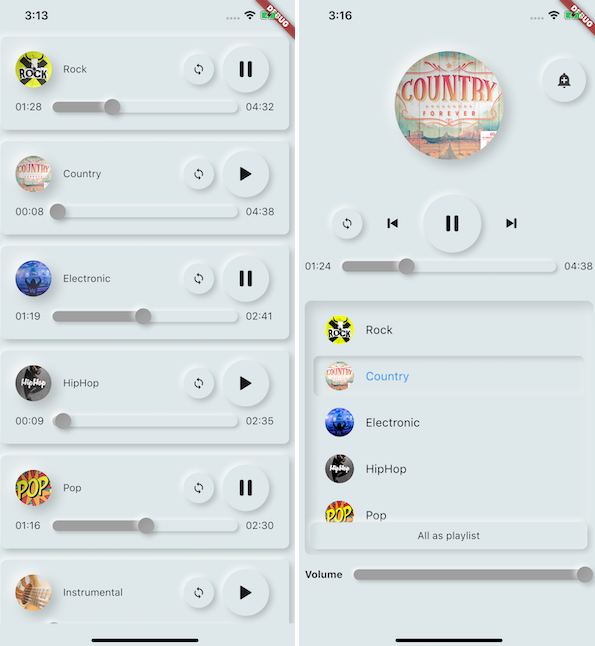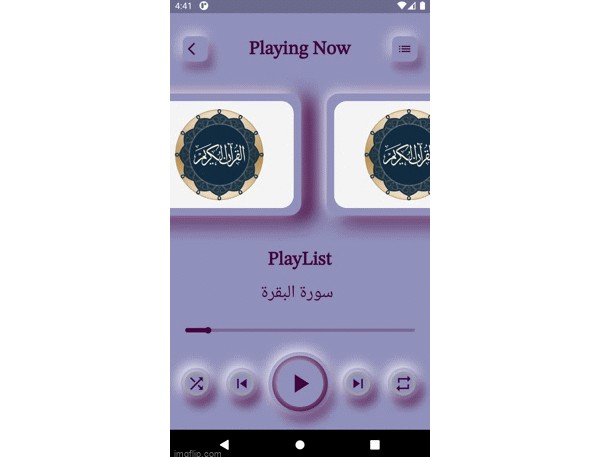assets_audio_player
Play music/audio stored in assets files (simultaneously) directly from Flutter (android / ios / web).
You can also use play audio files from network using their url
flutter:
assets:
- assets/audios/
AssetsAudioPlayer.newPlayer().open(
Audio("assets/audios/song1.mp3"),
autoPlay: true,
);
? Import
dependencies:
assets_audio_player: ^1.4.7+4
Works with flutter: ">=1.12.13+hotfix.6 <2.0.0", be sure to upgrade your sdk
? Web support
And if you wan web support, enable web then add
dependencies:
assets_audio_player_web: ^1.4.7+4
You like the package ? buy me a kofi :)
| Audio Source | Android | iOS | Web |
|---|---|---|---|
| Asset file (asset path) | ✅ | ✅ | ✅ |
| Network file (url) | ✅ | ✅ | ✅ |
| Local file (path) | ✅ | ✅ | ✅ |
| Network LiveStream (url) | ✅ | ✅ | ✅ |
| Commands | Android | iOS | Web |
|---|---|---|---|
| Play | ✅ | ✅ | ✅ |
| Pause | ✅ | ✅ | ✅ |
| Stop | ✅ | ✅ | ✅ |
| Seek(position) | ✅ | ✅ | ✅ |
| SeekBy(position) | ✅ | ✅ | ✅ |
| Forward(speed) | ✅ | ✅ | ✅ |
| Rewind(speed) | ✅ | ✅ | ✅ |
| Next | ✅ | ✅ | ✅ |
| Prev | ✅ | ✅ | ✅ |
| Feature | Android | iOS | Web |
|---|---|---|---|
| Multiple players | ✅ | ✅ | ✅ |
| Open Playlist | ✅ | ✅ | ✅ |
| system notification | ✅ | ✅ | ? |
| Respect System silent mode | ✅ | ✅ | ? |
| Pause on phone call | ✅ | ✅ | ? |
| Audio Widget | ✅ | ✅ | ✅ |
| Properties | Android | iOS | Web |
|---|---|---|---|
| Loop | ✅ | ✅ | ✅ |
| get/set Volume | ✅ | ✅ | ✅ |
| get/set Play Speed | ✅ | ✅ | ✅ |
| Listeners | Android | iOS | Web |
|---|---|---|---|
| Listener onReady(completeDuration) | ✅ | ✅ | ✅ |
| Listener currentPosition | ✅ | ✅ | ✅ |
| Listener finished | ✅ | ✅ | ✅ |
| Listener buffering | ✅ | ✅ | ✅ |
| Listener volume | ✅ | ✅ | ✅ |
| Listener Play Speed | ✅ | ✅ | ✅ |
? Import assets files
No needed to copy songs to a media cache, with assets_audio_player you can open them directly from the assets.
- Create an audio directory in your assets (not necessary named "audios")
- Declare it inside your pubspec.yaml
flutter:
assets:
- assets/audios/
?️ Getting Started
final assetsAudioPlayer = AssetsAudioPlayer();
assetsAudioPlayer.open(
Audio("assets/audios/song1.mp3"),
);
You can also play network songs from url
final assetsAudioPlayer = AssetsAudioPlayer();
try {
await assetsAudioPlayer.open(
Audio.network("http://www.mysite.com/myMp3file.mp3"),
);
} catch (t) {
//mp3 unreachable
}
And play songs from file
//create a new player
final assetsAudioPlayer = AssetsAudioPlayer();
assetsAudioPlayer.open(
Audio.file(FILE_URI),
);
assetsAudioPlayer.playOrPause();
assetsAudioPlayer.play();
assetsAudioPlayer.pause();
assetsAudioPlayer.seek(Duration to);
assetsAudioPlayer.seekBy(Duration by);
assetsAudioPlayer.forwardRewind(double speed);
//if positive, forward, if negative, rewind
assetsAudioPlayer.stop();
Notifications


on iOS, it will use MPNowPlayingInfoCenter
- Add metas inside your audio
final audio = Audio("/assets/audio/country.mp3",
metas: Metas(
title: "Country",
artist: "Florent Champigny",
album: "CountryAlbum",
image: MetasImage.asset("assets/images/country.jpg"), //can be MetasImage.network
),
);
- open with
showNotification: true
_player.open(audio, showNotification: true)
⛓ Play in parallel / simultaneously
You can create new AssetsAudioPlayer using AssetsAudioPlayer.newPlayer(),
which will play songs in a different native Media Player
This will enable to play two songs simultaneously
You can have as many player as you want !
///play 3 songs in parallel
AssetsAudioPlayer.newPlayer().open(
Audio("assets/audios/song1.mp3")
);
AssetsAudioPlayer.newPlayer().open(
Audio("assets/audios/song2.mp3")
);
//another way, with create, open, play & dispose the player on finish
AssetsAudioPlayer.playAndForget(
Audio("assets/audios/song3.mp3")
);
Each player has an unique generated id, you can retrieve or create them manually using
final player = AssetsAudioPlayer.withId(id: "MY_UNIQUE_ID");
Playlist
assetsAudioPlayer.open(
Playlist(
assetAudioPaths: [
"assets/audios/song1.mp3",
"assets/audios/song2.mp3"
]
)
);
assetsAudioPlayer.next();
assetsAudioPlayer.prev();
assetsAudioPlayer.playAtIndex(1);
Audio Widget
If you want a more flutter way to play audio, try the AudioWidget !

//inside a stateful widget
bool _play = false;
@override
Widget build(BuildContext context) {
return Audio.assets(
path: "assets/audios/country.mp3",
play: _play,
child: RaisedButton(
child: Text(
_play ? "pause" : "play",
),
onPressed: () {
setState(() {
_play = !_play;
});
}
),
onReadyToPlay: (duration) {
//onReadyToPlay
},
onPositionChanged: (current, duration) {
//onReadyToPlay
},
);
}
How to ? stop ? the AudioWidget ?
Just remove the Audio from the tree !
Or simply keep play: false
? Listeners
All listeners exposes Streams
Using RxDart, AssetsAudioPlayer exposes some listeners as ValueObservable (Observable that provides synchronous access to the last emitted item);
? Current song
//The current playing audio, filled with the total song duration
assetsAudioPlayer.current //ValueObservable<PlayingAudio>
//Retrieve directly the current played asset
final PlayingAudio playing = assetsAudioPlayer.current.value;
//Listen to the current playing song
assetsAudioPlayer.current.listen((playingAudio){
final asset = playingAudio.assetAudio;
final songDuration = playingAudio.duration;
})
⌛ Current song duration
//Listen to the current playing song
final duration = assetsAudioPlayer.current.value.duration;
⏳ Current position (in seconds)
assetsAudioPlayer.currentPosition //ValueObservable<Duration>
//retrieve directly the current song position
final Duration position = assetsAudioPlayer.currentPosition.value;
return StreamBuilder(
stream: assetsAudioPlayer.currentPosition,
builder: (context, asyncSnapshot) {
final Duration duration = asyncSnapshot.data;
return Text(duration.toString());
}),
or use a PlayerBuilder !
PlayerBuilder.currentPosition(
player: _assetsAudioPlayer,
builder: (context, duration) {
return Text(duration.toString());
}
)
▶ IsPlaying
boolean observable representing the current mediaplayer playing state
assetsAudioPlayer.isPlaying // ValueObservable<bool>
//retrieve directly the current player state
final bool playing = assetsAudioPlayer.isPlaying.value;
//will follow the AssetsAudioPlayer playing state
return StreamBuilder(
stream: assetsAudioPlayer.isPlaying,
builder: (context, asyncSnapshot) {
final bool isPlaying = asyncSnapshot.data;
return Text(isPlaying ? "Pause" : "Play");
}),
or use a PlayerBuilder !
PlayerBuilder.isPlaying(
player: _assetsAudioPlayer,
builder: (context, isPlaying) {
return Text(isPlaying ? "Pause" : "Play");
}
)
? Volume
Change the volume (between 0.0 & 1.0)
assetsAudioPlayer.setVolume(0.5);
The media player can follow the system "volume mode" (vibrate, muted, normal)
Simply set the respectSilentMode optional parameter as true
_player.open(PLAYABLE, respectSilentMode: true);
https://developer.android.com/reference/android/media/AudioManager.html?hl=fr#getRingerMode()
https://developer.apple.com/documentation/avfoundation/avaudiosessioncategorysoloambient
Listen the volume
return StreamBuilder(
stream: assetsAudioPlayer.volume,
builder: (context, asyncSnapshot) {
final double volume = asyncSnapshot.data;
return Text("volume : $volume");
}),
or use a PlayerBuilder !
PlayerBuilder.volume(
player: _assetsAudioPlayer,
builder: (context, volume) {
return Text("volume : $volume");
}
)
✋ Finished
Called when the current song has finished to play,
it gives the Playing audio that just finished
assetsAudioPlayer.playlistAudioFinished //ValueObservable<Playing>
assetsAudioPlayer.playlistAudioFinished.listen((Playing playing){
})
Called when the complete playlist has finished to play
assetsAudioPlayer.playlistFinished //ValueObservable<bool>
assetsAudioPlayer.playlistFinished.listen((finished){
})
? Looping
final bool isLooping = assetsAudioPlayer.loop; //true / false
assetsAudioPlayer.loop = true; //set loop as true
assetsAudioPlayer.isLooping.listen((loop){
//listen to loop
})
assetsAudioPlayer.toggleLoop(); //toggle the value of looping
Network Policies (android/iOS)
Android only allow HTTPS calls, you will have an error if you're using HTTP,
don't forget to add INTERNET permission and seet usesCleartextTraffic="true" in your AndroidManifest.xml
<?xml version="1.0" encoding="utf-8"?>
<manifest ...>
<uses-permission android:name="android.permission.INTERNET" />
<application
...
android:usesCleartextTraffic="true"
...>
...
</application>
</manifest>
iOS only allow HTTPS calls, you will have an error if you're using HTTP,
don't forget to edit your info.plist and set NSAppTransportSecurity to NSAllowsArbitraryLoads
<key>NSAppTransportSecurity</key>
<dict>
<key>NSAllowsArbitraryLoads</key>
<true/>
</dict>







